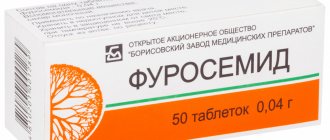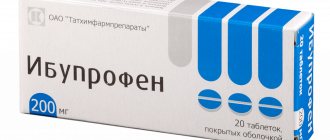Features of the composition and action of Spironolactone
The medicine is prepared in tablets and contains 25 or 100 mg of the active ingredient spironolactone. Additional components of the composition are presented:
- calcium stearate;
- povidone;
- lactose;
- potato starch;
- monohydrate.
Each package of medication contains 20, 30 tablets. Spironolactone is a diuretic that accelerates the elimination of sodium and chlorine from the body, reduces uric acidity, and preserves potassium and magnesium. The therapeutic effect occurs within 2-5 days from the start of administration.
Spironolactone FT tablets 50 mg No. 10x3
Name
Spironolactone Pharmtechnology.
Release forms
Tablets.
INN
Spironolactone.
FTG
Diuretic potassium-sparing agent.
Description
25 mg tablets are white or almost white flat-cylindrical round tablets with a chamfer, with a characteristic mercaptan odor. Tablets 50 mg and 100 mg are white or almost white flat-cylindrical round tablets with a score and bevel, with a characteristic mercaptan odor.
Compound
Active substance: spironolactone 25 mg, 50 mg or 100 mg. Excipients: corn starch, povidone, talc, colloidal anhydrous silicon dioxide, magnesium stearate, lactose monohydrate.
Pharmacotherapeutic group
Potassium-sparing diuretics. Aldosterone antagonist. ATC code: C03DA01.
Pharmacological properties
Spironolactone is an aldosterone antagonist that acts as a potassium-sparing diuretic by increasing the excretion of sodium and water from the body while delaying the excretion of potassium and magnesium. The maximum effect is observed 7 hours after ingestion and lasts for at least 24 hours.
Indications for use
Congestive heart failure. Liver cirrhosis with ascites and edema Malignant ascites. Nephrotic syndrome. Diagnosis and treatment of primary aldosteronism.
Directions for use and doses
Orally once a day with meals. Adults Congestive heart failure with edema: To reduce edema, the initial daily dose of SPIRONOLACTONE is 100 mg once or in two divided doses, but can vary from 25 mg to 200 mg per day. The maintenance dose is determined individually. In patients with severe heart failure (NYHA class III-IV): Based on clinical trial data, treatment in combination with standard therapy is recommended to begin with spironolactone 25 mg once daily when potassium levels are ≤ 5.0 mEq/L and creatinine. serum ≤ 2.5 mg/dl. If treatment is well tolerated according to clinical indications, the dose is increased to 50 mg once a day. If the drug is poorly tolerated by the patient, the dose is reduced to 25 mg every other day. Liver cirrhosis with ascites and edema: if the Na+/K+ ratio in the urine is more than 1.0, SPIRONOLACTONE is prescribed in a daily dose of 100 mg per day. If the ratio is less than 1.0, then daily doses of the drug vary from 200 to 400 mg. The dose for each patient is determined individually. Malignant ascites: the usual dose is 100-200 mg per day. In severe cases, the dose can be gradually increased to 400 mg per day. Based on the dynamics of the development of edema syndrome, the maintenance dose should be determined individually. Nephrotic syndrome: the usual dose is 100-200 mg per day. Spironolactone does not affect the underlying pathological process. Prescription of the drug is recommended only if treatment with glucocorticoids is ineffective. Diagnosis and treatment of primary aldosteronism: Spironolactone can be used as an initial diagnostic test to determine primary hyperaldosteronism in patients on a standard diet. Long test: spironolactone is prescribed at a daily dose of 400 mg for three to four weeks. Correction of hypokalemia and arterial hypertension suggests a diagnosis of primary hyperaldosteronism. Short test: the drug is prescribed at a daily dose of 400 mg for four days. If serum potassium levels increase while spironolactone is being taken but decrease when it is discontinued, a presumptive diagnosis of primary hyperaldosteronism should be considered. Once hyperaldosteronism has been diagnosed by definitive testing procedures, spironolactone is recommended to be administered in doses of 100 mg to 400 mg daily in preparation for surgery. If there are no indications for surgery, then the drug is used for long-term maintenance therapy at the lowest effective dose, which is determined individually for each patient. Elderly patients Treatment is recommended to begin with low doses, followed by titration until maximum effect is achieved. Caution should be exercised in severe hepatic and renal impairment, which alter the metabolism and elimination of the drug. Children The initial daily dose should be 3 mg of spironolactone per kilogram of body weight. Dosage should be adjusted based on response and tolerability. If necessary, a suspension can be obtained by crushing SPIRONOLACTONE tablets. Side effects Gynecomastia may develop in connection with the use of SPIRONOLACTONE. Its occurrence is related to both the dose and duration of treatment. As a rule, gynecomastia is reversible and goes away after stopping the drug. In rare cases, some breast enlargement may persist. From the endocrine system: gynecomastia, erectile dysfunction in men; soreness and enlargement of the mammary glands, menstrual dysfunction, infertility, hirsutism, deepening of the voice in women; decreased libido. From the gastrointestinal tract: nausea, vomiting, stomach pain, gastritis, ulceration and gastrointestinal bleeding, diarrhea. From the hepatobiliary system: liver dysfunction. From the cardiovascular system: arrhythmias, vasculitis, hypotension. From the side of the central nervous system: drowsiness, headache, confusion, asthenia, cramps of the calf muscles, paralysis, paraplegia. From the blood and lymphatic system: thrombocytopenia, agranulocytosis, eosinophilia. Skin and subcutaneous tissue disorders: skin rash, itching, urticaria, alopecia, eczema, erythema annulare, hypertrichosis, lupus-like syndrome, Stevens-Johnson syndrome (SJS), toxic epidermal necrolysis (TEN), rash accompanied by eosinophilia and systemic symptoms (DRESS syndrome). Metabolic: hyperkalemia, hyponatremia, dehydration, porphyria, osteomalacia, hyperchloremic acidosis. From the musculoskeletal system: cramps of the calf muscles. From the urinary system: acute renal failure. From the immune system: hypersensitivity. Neoplasms benign, malignant and unspecified (including cysts and polyps): benign breast tumors. General disorders: general weakness. If any side effect occurs or worsens, whether it is described in this section or not, you should contact your doctor immediately.
Contraindications
hypersensitivity to spironolactone or any of the excipients. acute renal failure. anuria. severe impairment of renal excretory function (with creatinine clearance
Pregnancy and lactation
In preclinical studies in rats, spironolactone caused feminization when administered to males. It is known that spironolactone and its metabolites cross the human placental barrier and are excreted in breast milk. Therefore, the drug should not be used during pregnancy and breastfeeding. Children Not recommended for use in children under 6 years of age.
Overdose
Symptoms of acute overdose: nausea, vomiting, drowsiness, confusion, dizziness, diarrhea, skin rash. Possible development of hyponatremia or hyperkalemia, dehydration. Hyperkalemia may manifest as paresthesia, weakness, flaccid paralysis, or muscle spasm. Clinically, these symptoms are difficult to distinguish from hypokalemia. Electrocardiographic changes are the earliest specific signs of disturbances in the level of potassium in the blood (a tall, pointed T wave with a shortening of the QT interval and a decrease in the amplitude of the P wave with a widening of the QRS complex). Severe heart rhythm disturbances are possible in the form of atrial fibrillation, atrioventricular block, up to cardiac arrest. Treatment: the drug should be discontinued immediately, induce vomiting and rinse the stomach. There is no specific antidote. Hyperkalemia is eliminated by rapid intravenous administration of 20-50% glucose with regular insulin (0.25-0.5 U/g glucose). Symptomatic treatment of water-electrolyte imbalances, dehydration and arterial hypotension is carried out. Saluretics and ion exchange resins are prescribed. Hemodialysis may be used. It is recommended to reduce potassium intake (including potassium-rich foods and dietary supplements).
Precautionary measures
Concomitant use of spironolactone with drugs that can cause an increase in potassium levels in the blood (potassium-sparing diuretics, ACE inhibitors, angiotensin II receptor antagonists, heparin and low molecular weight heparins), potassium supplements, potassium-containing salt substitutes, as well as a diet rich in potassium, can lead to serious hyperkalemia. While taking spironolactone, the risk of developing hyperkalemia in patients with diabetic nephropathy increases. Hyperkalemia in patients with severe heart failure can be life-threatening. It is very important to carefully monitor serum potassium levels. Potassium supplements and other potassium-sparing diuretics should not be used in patients with potassium levels above 3.5 mmol/L. It is recommended to monitor blood potassium and creatinine levels one week after starting treatment or increasing the dose of spironolactone, monthly for the first 3 months, then quarterly for a year, and every 6 months thereafter. Stop or interrupt treatment if serum potassium level is more than 5 mmol/L or creatinine level is more than 4 mg/dL. It has been reported that reversible hyperchloremic metabolic acidosis may occur with spironolactone therapy in some patients with decompensated liver cirrhosis due to hyperkalemia, even with normal renal function. Spironolactone may cause a reversible increase in serum urea nitrogen in patients with impaired renal function and hyperkalemia. Caution should be exercised when prescribing to patients prone to hyperkalemia and acidosis (diabetes mellitus). When performing a glucose tolerance test in patients with diabetic nephropathy, spironolactone should be discontinued at least 3 days before the test (due to the risk of severe hyperkalemia). When prescribing spironolactone to patients with impaired renal and hepatic function and elderly patients, electrolyte balance and renal function should be regularly monitored. In patients with moderate renal impairment (serum creatinine from 1.2 mg/100 ml to 1.8 mg/100 ml or creatinine clearance from 60 ml/min to 30 ml/min), hypotension or hypovolemia, caution should also be exercised. Treatment with spironolactone may interfere with the determination of serum digoxin, epinephrine and cortisol in the blood plasma. During treatment, alcohol consumption is prohibited. It should be taken into account that the excipients of the drug include lactose monohydrate. SPIRONOLACTONE should not be prescribed to patients with hereditary lactose intolerance, lactase deficiency and glucose-galactose malabsorption.
Effect on the ability to drive and use machines
SPIRONOLACTONE, especially at the beginning of treatment, may cause drowsiness and dizziness in some patients. Therefore, during this period you should refrain from driving vehicles and potentially dangerous activities that require a quick psychomotor reaction and concentration. In the future, the restriction is determined by the doctor individually for each patient.
Interaction with other drugs
Concomitant use of SPIRONOLACTONE with other potassium-sparing diuretics, aldosterone receptor blockers, ACE inhibitors, angiotensin II receptor antagonists, heparin and low molecular weight heparins, with potassium-containing drugs can lead to severe hyperkalemia. In combination with other diuretics, the diuretic effect is enhanced. Spironolactone increases the half-life of digoxin, which leads to an increase in its concentration and the development of glycoside intoxication. In this regard, when taking them together, it is recommended to reduce the dose or increase the interval between doses of digoxin. With antihypertensive drugs, the effect is potentiated and their dosage may need to be reduced. Because ACE inhibitors reduce aldosterone production, they should not be routinely administered with spironolactone, especially in patients with severe renal impairment. Alcohol, barbituric acid derivatives, and narcotic analgesics potentiate the hypotension caused by spironolactone. Concomitant use of carbenoxolone may result in sodium retention and thus reduce the effectiveness of spironolactone. Nonsteroidal anti-inflammatory drugs can reduce the natriuretic, diuretic, and hypotensive effects of diuretics by inhibiting intrarenal prostaglandin synthesis. Spironolactone reduces the vascular response to norepinephrine. Caution should be exercised when administering anesthesia to patients taking SPIRONOLACTONE. Spironolactone increases the metabolism of antipyrine. When used simultaneously with glucocorticosteroids and adrenocorticotropic hormone, an increase in potassium excretion occurs. When taken concomitantly with carbamazepine, clinically significant hyponatremia may develop. Spironolactone weakens the effect of coumarin derivatives. With long-term administration of spironolactone with lithium preparations, an increase in serum lithium concentration is possible. Spironolactone enhances the effects of buserelin, triptorelin, gonadorelin. Cyclosporine and tacrolimus increase the risk of hyperkalemia. Cholestyramine and ammonium chloride increase the risk of hyperkalemia and hyperchloremic metabolic acidosis.
Package
Tablets 25 mg in blister packs No. 10×2, No. 10×3, No. 10×5 and in jars No. 20, No. 30, No. 100. Tablets 50 mg in blister packs No. 10×2, No. 10×3, No. 10×5 and in jars No. 20, No. 30, No. 50. Tablets 100 mg in jars No. 20, No. 30. Together with the leaflet, two, three or five blister packs or one jar are placed in a cardboard pack.
Storage conditions
Store at a temperature not exceeding 25 °C. Keep out of the reach of children.
Best before date
2 years. The expiration date is indicated on the packaging. Do not use after the date indicated on the package.
Conditions for dispensing from pharmacies
By doctor's prescription.
Buy Spironolactone FT tablets 50 mg No. 10x3 in the pharmacy
Price for Spironolactone FT tablets 50 mg No. 10x3
Instructions for use for Spironolactone FT tablets 50 mg No. 10x3
Indications and contraindications
The instructions recommend the use of Spironolactone for the following pathologies:
- with premenstrual, nephrotic syndrome;
- Conn's syndrome, polycystic ovaries;
- increased blood pressure;
- swelling that occurs in the second half of pregnancy or with CHF;
- cirrhosis of the liver.
The medication is contraindicated:
- in case of individual intolerance to the component composition;
- menstrual irregularities;
- the first three months of gestation;
- unstable acid-base balance;
- diabetic glomerulosclerosis;
- diabetes mellitus, chronic renal failure;
- liver dysfunction, in the absence of urine entering the bladder;
- low sodium concentration in the blood;
- increased levels of calcium and potassium.
The drug is prohibited for patients with Addison's disease.
Veroshpiron recipe
Quite often, it is not a prescription for spironolactone that is prescribed, but a prescription for veroshpiron. The active ingredients of these drugs are the same.
At a dosage of 25 mg
- Rp. Tab “Verospiron” 25 mg N 30 DS Orally 1 tablet 2 times a day
- Rp. Tab “Verospiron” 0.025 N 30 DS Orally 1 tablet 2 times a day
At a dosage of 50 mg
- Rp. Tab “Verospiron” 50 mg N 30 DS Orally 1 tablet 1 time per day
- Rp. Tab “Verospiron” 0.05 N 30 DS Orally 1 tablet 1 time per day
At a dosage of 100 mg
- Rp. Tab “Verospiron” 100 mg N 30 DS Orally 1 tablet 1 time per day
- Rp. Tab “Verospiron” 0.1 N 30 DS Orally 1 tablet 1 time per day
Adverse reactions to Spironolactone therapy
Therapeutic procedures can cause non-standard effects, manifested by:
- muscle spasms, decreased potency levels;
- allergies with obsessive itching, medicinal and nettle fever, skin rashes;
- carcinoma and painful sensations in the mammary glands, rough voice;
- absence of menstruation or recurring discomfort with each menstruation;
- excessive hair growth, enlarged mammary glands;
- bloody discharge during menopause;
- dyspepsia, intestinal colic, hemorrhages in the gastrointestinal tract;
- gastritis, stomach ulcers, pain in the abdominal area;
- attacks of nausea with vomiting, headache;
- drowsiness, dizziness, lethargy;
- movement coordination disorder, lethargy;
- an increase in alkali and urea levels in the bloodstream.
In laboratory diagnostics, adverse reactions are manifested by a decrease in the number of neutrophils, deficiency of folic acid, and platelets.
The nuances of Spironolactone therapy
The tablets are taken once a day with food. Dosages for adults are prescribed in the instructions for the drug:
- for congestive heart failure with edema - 100 mg once, then the dose is adjusted depending on the body's reaction to 25-200 mg per day;
- severe heart failure - 25 mg per day, if well tolerated - up to 50 mg per day;
- ascites and edema due to liver cirrhosis - from 200 to 400 mg daily;
- malignant form of ascites - from 100 to 200 mg, then the volume gradually increases to 400 mg daily;
- nephrotic syndrome - from 100 to 200 mg per day.
Elderly patients are prescribed minimum dosages, which are gradually increased until the expected effect is achieved. Particular caution is required when treating patients with complex renal or hepatic insufficiency that can alter the metabolism of medications.
For children, the initial dosage is 3 mg per kilogram of weight. Dose adjustment is carried out according to the tolerability of Spironolactone. For children, it is possible to create a suspension from crushed tablets and water.
Publications in the media
(Spironolactonum) INN
Synonyms. Aldakton, Veroshpiron.
Composition and release form. Spironolactone tablets 0.025 g.
Indications. Edema caused by heart failure, liver cirrhosis, nephrotic syndrome; swelling caused by the use of corticosteroids, estrogens; idiopathic edema; hypertonic disease; hypokalemia.
Pharmachologic effect. Spironolactone is a potassium-sparing diuretic, and its diuretic effect is associated with aldosterone antagonism, that is, it competitively inhibits the action of aldosterone. The drug acts on the distal tubules of the nephron, increasing the excretion of sodium and water, but decreasing the excretion of potassium and urea. Spironolactone has been successfully used as an antihypertensive agent to treat patients in whom increased aldosterone production predominates (usually in combination with thiazide diuretics).
Pharmacokinetics. Spironolactone is well absorbed from the gastrointestinal tract into the blood, its bioavailability is more than 90%. Eating increases the absorption of spironolactone. The drug is metabolized in the liver with the formation of a pharmacologically active metabolite - canrenone (25-30% of the dose taken). The plasma protein binding of spironolactone and canrenone is very high - more than 90%. T1/2 of spironolactone-canrenone ranges from 13 to 24 hours (average 19 hours) when the drug is taken orally once or twice a day; when taking the drug 4 times a day, T1/2 ranges from 9 to 16 hours (on average 12.5 hours). The time for the onset of a pronounced diuretic effect with repeated administration of the drug is the second or third day. Spironolactone and metabolites are excreted mainly by the kidneys (10% unchanged) and through the gastrointestinal tract.
Side effects. Hyperkalemia, hyponatremia; gynecomastia; drowsiness; skin rash; ataxia; Gastrointestinal irritation (nausea, vomiting, stomach cramps, diarrhea).
Contraindications. Anuria or acute renal failure; diabetes mellitus, diabetic nephropathy; severe liver failure; hyponatremia; hypersensitivity to the drug; incomplete AV heart block; first trimester of pregnancy, menstrual irregularities; enlargement of the mammary glands in men.
Adverse reactions when interacting with other drugs. Spironolactone may increase the half-life of digoxin when taken together; It is recommended to reduce the dose of digoxin with this combination or increase the interval between doses of digoxin. It is not recommended to prescribe spironolactone with drugs that cause gynecomastia.
Information for the patient. Spironolactone is highly soluble in lipids in the presence of bile acids released during food intake, so the drug must be administered after meals. The daily dose varies from 0.05 to 0.3 g, but is usually 0.1-0.2 g (in 2-4 doses). If spironolactone is added to therapy with other diuretics or antihypertensive agents, it is recommended to reduce the doses of all drugs by 50%. Elderly patients have an increased risk of developing hyperkalemia. Missed dose - see hydrochlorothiazide. Patients receiving spironolactone require weight and dietary control, especially control of salt intake. Avoid foods rich in potassium. With long-term treatment with spironolactone in men, enlargement of the mammary glands is possible.
Features of overdose and interaction
Accidental use of large doses of the drug can become a source of:
- dehydration of the body and increase in the amount of urea;
- excess calcium, potassium and lack of sodium;
- skin rashes, diarrhea;
- attacks of dizziness with nausea and vomiting.
Therapeutic measures to relieve intoxication include gastric lavage, restoration of water balance and treatment of high blood pressure. In difficult cases, the patient is prescribed hemodialysis procedures.
The instructions note that combination with certain drugs may change the effectiveness of Spironolactone:
- Gonadorelin, Buserelin, Triptorelin - their effect is enhanced;
- Lithium carbonate – increases the amount of lithium in the bloodstream;
- Cholestyramine – provokes potassium deficiency;
- Eprosartan, Losartan, Candesartan - increases potassium concentration.
Hyperkalemia is observed when combined with potassium-sparing diuretics, table salt substitutes, etc.
Spironolactone analogues
Spironolactone is a potassium-sparing diuretic. Refers to synthetic aldosterone antagonists. Below are the most common analogues of spironolactone in Latin:
- Verospiron
- Aldactone
- Spironol
Spironolactone is included in combination drugs with thiazide diuretics, often with altizide for the treatment of edema and hypertension
- Aldactazide
- Aldactazine
- Aldactatide,
- Aldozone,
- Altexide,
- Practazin,
- Prinactizide
- Spiroctazine.







